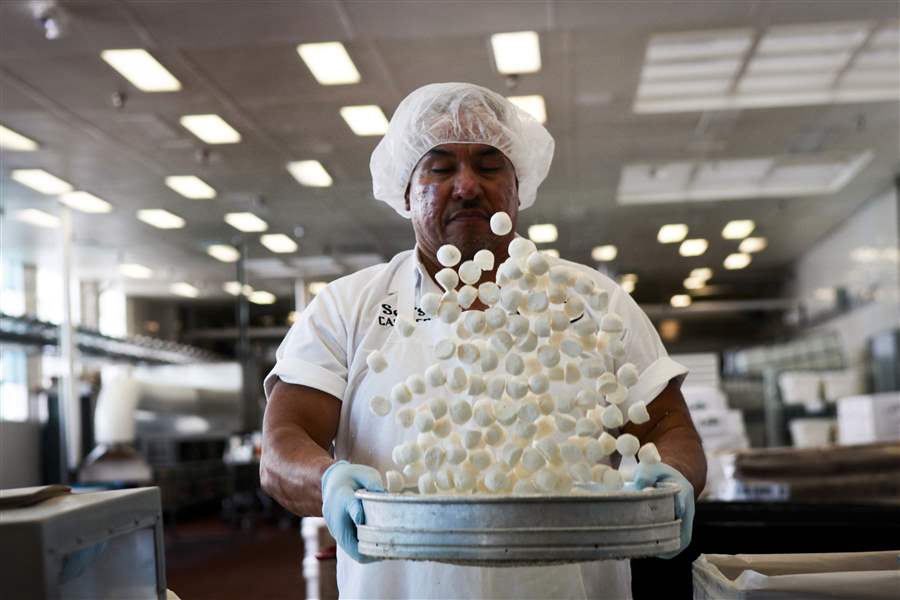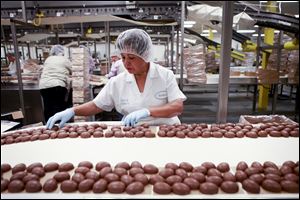
Chocolate makers adjusting recipes for sweeter success
4/22/2013
New technologies have led to a gradual workforce reduction over the years at the See's Candies factory in Los Angeles, California, but theres still plenty done by hand. Above, Arturo Barboza tosses house-made honey marshmallows, the start of the company's Rocky Road eggs.
Los Angeles Times

New technologies have led to a gradual workforce reduction over the years at the See's Candies factory in Los Angeles, California, but theres still plenty done by hand. Above, Bertha Ramos sorts through freshly-coated chocolate marshmallow eggs before they are sent off to be boxed and packaged.
LOS ANGELES — In 92 years, See’s Candies has never shied away from being old-fashioned.
At the factory on La Cienega Boulevard in Los Angeles, some octogenarian workers measure their decades of employment in hip replacements. Quaint floral details are still hand-piped onto chocolate eggs.
An inexorable march of candies heads through tubes the length of a football field, where they’re drenched in layers of chocolate — a traditional practice known as enrobing. Like cars merging out of highway toll lanes, they appear from cooling tunnels into employees’ waiting hands.
“Old Time” is part of See’s slogan. But the South San Francisco company is evolving along with the rest of the chocolate industry, forced by predicaments far more severe than I Love Lucy conveyor-belt hijinks.
Chocolate is a huge business, pulling in $90 billion in global sales annually, $19 billion of it in the United States, according to market research company Mintel Group Ltd. Price increases and product innovation helped the industry grow 16 percent from 2007 through 2012, the firm found.
But scientists predict a looming cocoa bean shortage, intensified by climate change and botanical disease.

New technologies have led to a gradual workforce reduction over the years at the See's Candies factory in Los Angeles, California, but theres still plenty done by hand. Above, Arturo Barboza tosses house-made honey marshmallows, the start of the company's Rocky Road eggs.
The International Cocoa Organization said that global production in the last growing year fell 6.1 percent, and it forecasts a 1.8 percent slide this year.
Tighter supplies as well as rising sugar and manufacturing costs are adding to the price of truffles and bonbons. Sugar prices have risen 11.6 percent on average in each of the past five years, influencing Hershey Co.’s decision in 2011 to raise wholesale prices on most of its candy products by 9.7 percent.
In addition, health-minded U.S. consumers, increasingly wary of sugary snacks, are nibbling more on fresh fruit and less on chocolate, according to research firm NPD.
“Chocolate is an impulse item, an indulgence,” said Marcia Mogelonsky, an analyst at Mintel. “But consumers have become price-sensitive to chocolate — the economy is so bad that people are actually cutting back on their consumption.”
So what’s an Oompa Loompa to do? Switch up the chocolate strategy.
Companies are looking to countries not known as major cocoa producers, such as Vietnam and China, to boost production. Mondelez International Inc., owner of brands such as Cadbury and Toblerone, said it would invest $400 million in the next decade to improve cocoa farming communities and help boost productivity; other massive candy sellers have taken similar steps.
In the U.S., advances in technology and equipment contributed to layoffs, causing chocolate employment to slide 2.2 percent a year on average since 2007, according to research firm IBISWorld. Simultaneously, chocolate companies are trimming wages to cut costs and boost profit, according to researchers.
Manufacturers also are creating innovative new chocolates and manufacturing methods to try to differentiate themselves from competitors.
British brand Cadbury last year unveiled a new form of the sweet that’s resistant to melting, even at 104 degrees Fahrenheit. TCHO Ventures Inc., a San Francisco chocolate company, makes chocolate by controlling its machinery with an iPhone app.
Companies are also trying to entice body-conscious consumers, which IBISWorld believes will give organic and dark chocolates a boost in coming years. Brands such as Russell Stover have significant sugar-free chocolate selections; others are branching out into gluten-free and dairy-free offerings.
And candy sizes are shrinking.
By the end of this year, all of Mars Inc.’s chocolate brands — Snickers, Dove, and M&M’s among them — will be available only in 250-calorie portions or less.
Brands are adjusting their marketing efforts, especially during holidays.
This year, companies launched more seasonal products instead of holiday-specific candies, which usually head straight to discount racks once celebrations are over. Hershey introduced an array of candies in spring colors, rather than wrapped kisses emblazoned with the word “Easter.”
“The move is to stretch the occasion beyond a day,” Ms. Mogelonsky said. “Companies have to extend the salability of the product, or they’ll lose money.”
At the Los Angeles factory of See’s, the air is thick with the smells of chocolate and caramel.
Workers in hairnets, white coats, and gloves prepare chocolates destined for the chain’s more than 200 company-owned stores, primarily in the West, as well as online and catalog customers. The company also operates a factory in the San Francisco Bay Area.
For 41 years, See’s has been a tiny but reliable part of investment guru Warren Buffett’s Berkshire Hathaway Inc. The candy maker, which Mr. Buffett bought for $25 million in 1972, belongs to the Oracle of Omaha’s wide-ranging retail stable, which includes home furnishings, jewelry, cooking equipment, and party supplies.
At its kitchens and stores, the company employs some 1,500 workers during its slower summer season, expanding to 8,000 workers during the holidays. It recently has been adding to its stores outside its Western territory, venturing into Texas, Ohio, and Indiana. It plans to move into other states as well. Licensees manage six shops in Asia.
See’s has done well enough for Mr. Buffett to praise it to shareholders as a “dream business.” In 2011, the company posted pretax profit of $83 million on sales of $376 million. See’s current annual sales are in the $400 million range, the company said.
Mr. Buffett has said that See’s has been such a steady performer that it has helped finance some of his other purchases over the years.
“ ‘Buy commodities, sell brands’ has long been a formula for business success,” Mr. Buffett wrote in 2011. “It has produced enormous and sustained profits for Coca-Cola since 1886 and Wrigley since 1891. On a smaller scale, we have enjoyed good fortune with this approach at See’s Candy since we purchased it.”
But even at a stalwart such as See’s, efforts are apparent to adapt to the less-than-sweet changes facing the industry — although not on public display because the candy maker rarely offers tours.
As with the company’s Bay Area kitchen, which rivals the L.A. factory in size, some tasks that once were performed manually are now delegated to machines to improve efficiency and cut costs. There’s a machine nicknamed after the Looney Tunes canary Tweety Bird because of its yellow mechanical arm, which slices and flips sheets of peanut brittle near vats of butter on the factory floor.
Managers said the new technologies have caused a gradual reduction over the years in the Los Angeles facility’s workforce, which currently numbers about 150 people — a tally that doubles around Christmas as the company adjusts for seasonal demand.
Plenty remains to be done by hand, such as the painstaking decoration of tender chocolates and the removal of imperfect candies from the production lines. The company still uses matriarch Mary See’s original recipes but has raised prices in recent years to offset soaring ingredient costs.
There’s also a rebranding effort under way at See’s. Internally, the effort is dubbed Polishing Our Gem.
The Web site underwent a face lift to draw more online shoppers. A new catalog, with less clutter and new fonts and images, debuted around Valentine’s Day.
And See’s, which had focused on grandmothers and great-grandmothers, is now targeting young mothers in their 30s. The company says it needs the broader demographic to beat out intense competition.
“We just know that for growth, we need to onboard a new fan base,” said Tracy Cioffi, See’s vice president of marketing and advertising. “It’s a difficult dance, but it’s one we have to do.”